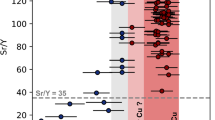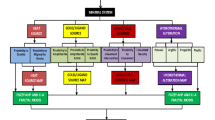Abstract
Multivariate methods are useful for simplifying the interpretation of variables in geochemical data and are widely used to uncover relationships between elements that are associated with geological and mineralization processes. Among these approaches, factor analysis (FA) is one of the most popular, whereas independent component analysis (ICA) has only been employed in a few cases. This study compared the effectiveness of these methods in distinguishing rock types and detecting mineralization signatures based on data on core samples obtained from the Nohkouhi copper deposit. The FA and ICA discriminated four known rock categories, namely barren rhyodacite, mineralized rhyodacite, barren black shale, and mineralized black shale. Stepwise linear discriminant analysis was used to compare the results of the FA and ICA and select components that effectively enable the discrimination of rock types and mineralization. First, rock types were distinguished with reference to the scores calculated via FA and ICA. The results showed that the FA and ICA achieved overall accuracy levels of 94% and 96% in rock-type discrimination, respectively. Second, each rock type was classified as either mineralized or barren. The FA exhibited classification accuracies of 76% for black shales and 70% for rhyodacites, whereas the ICA yielded classification accuracies of 79% and 88% for the two rock types, respectively.






Similar content being viewed by others
References
Afzal, P., Tehrani, M. E., Ghaderi, M., & Hosseini, M. R. (2016). Delineation of supergene enrichment, hypogene and oxidation zones utilizing staged factor analysis and fractal modeling in Takht-e-Gonbad porphyry deposit, SE Iran. Journal of Geochemical Exploration,161, 119–127.
Agterberg, F. P. (1974). Automatic contouring of geological maps to detect areas for mineral exploration. Mathematical Geology,6, 373–395.
Aitchison, J. (1982). The statistical analysis of compositional data. Journal of the Royal Statistical Society: Series B (Methodological), 44(2), 139–160.
Asadi, H. H., Kianpouryan, S., Lu, Y. J., & McCuaig, T. C. (2014). Exploratory data analysis and C–A fractal model applied in mapping multi-element soil anomalies for drilling: A case study from the Sari Gunay epithermal gold deposit, NW Iran. Journal of Geochemical Exploration,145, 233–241.
Asghari, O., & Hezarkhani, A. (2008). Appling discriminant analysis to separate the alteration zones within the Sungun porphyry copper deposit. Journal of Applied Sciences,24, 4472–4486.
Bonham-Carter, G. F., & Chung, C. F. (1983). Integration of mineral resource data for Kasmere Lake area, Northwest Manitoba, with emphasis on uranium. Mathematical Geology,15, 25–45.
BoroveC, Z. (1996). Evaluation of the concentrations of trace elements in stream sediments by factor and cluster analysis and the sequential extraction procedure. The Science of the Total Environment,177, 237–250.
Carranza, E. J. M. (2009). Geochemical anomaly and mineral prospectivity mapping in GIS. In M. Hale (Ed.), Handbook of exploration and environmental geochemistry (Vol. 11). Amsterdam: Elsevier.
Carranza, E. J. M. (2011). Analysis and mapping of geochemical anomalies using logratio-transformed stream sediment data with censored values. Journal of Geochemical Exploration,110(2), 167–185.
Davis, J. C. (2002). Statistics and data analysis in geology (3rd ed.). New York: Wiley.
De Sá, C. M., Noronha, F., & da Silva, E. F. (2014). Factor analysis characterization of minor element contents in sulfides from Pb–Zn–Cu–Ag hydrothermal vein deposits in Portugal. Ore Geology Reviews,62, 54–71.
Dillon, W. R., & Goldstein, M. (1984). Multivariate analysis methods and applications (No. 519.535 D5).
Fedikow, M. A. F., & Turek, A. (1983). The application of stepwise discriminant analysis to geochemical data from the host rocks of the Sullivan Pb–Zn–Ag deposit, Kimberley, BC, Canada. Journal of Geochemical Exploration,18(3), 231–244.
Filzmoser, P., Hron, K., Reimann, C., & Garrett, R. (2009). Robust factor analysis for compositional data. Computers & Geosciences,35(9), 1854–1861.
Gholami, R., Moradzadeh, A., & Yousefi, M. (2012). Assessing the performance of independent component analysis in remote sensing data processing. Journal of the Indian Society of Remote Sensing,40(4), 577–588.
Ghorbani, M. (2013). Economic geology of Iran. Berlin: Springer.
Hajsadeghi, S., Asghari, O., Mirmohammadi, M., & Meshkani, S. A. (2016). Indirect rock type modeling using geostatistical simulation of independent components in Nohkouhi volcanogenic massive sulfide deposit, Iran. Journal of Geochemical Exploration,168, 137–149.
Hajsadeghi, S., Mirmohammadi, M., Asghari, O., & Meshkani, S. A. (2018). Geology and mineralization at the copper-rich volcanogenic massive sulfide deposit in Nohkouhi, Posht-e-Badam block, Central Iran. Ore Geology Reviews,92, 379–396.
Harris, D. P. (1965). Multivariate statistical analysis—A decision tool for mineral exploration. In J. C. Dotson & W. C. Peters (Eds.), Symposium on computers and computer applications in mining and exploration (pp. C1–C35). Ariz: College of Mines, University of Arizona, Tucson.
Harris, D. P., & Pan, G. (1999). Mineral favorability mapping: A comparison of artificial neural networks, logistic regression, and discriminant analysis. Natural Resources Research,8, 93–109.
Harris, D. P., Zurcher, L., Stanley, M., Marlow, J., & Pan, G. (2003). A comparative analysis of favorability mappings by weights of evidence, probabilistic neural networks, discriminant analysis, and logistic regression. Natural Resources Research,12, 241–255.
Hyvärinen, A. (1999). Fast and robust fixed-point algorithms for independent component analysis. IEEE Transactions on Neural Networks,10(3), 626–634.
Hyvärinen, A., Karhunen, J., & Oja, E. (2001). Independent component analysis. New York: John Willey & Sons. Inc.
Hyvärinen, A., Karhunen, J., & Oja, E. (2004). Independent component analysis (Vol. 46). Hoboken: Wiley.
Hyvärinen, A., & Oja, E. (2000). Independent component analysis: algorithms and applications. Neural Networks,13(4), 411–430.
Iwamori, H., & Albarède, F. (2008). Decoupled isotopic record of ridge and subduction zone processes in oceanic basalts by independent component analysis. Geochemistry, Geophysics, Geosystems,9(4), 1–15.
Iwamori, H., Albaréde, F., & Nakamura, H. (2010). Global structure of mantle isotopic heterogeneity and its implications for mantle differentiation and convection. Earth and Planetary Science Letters,299(3), 339–351.
Jang, C. (2010). Applying scores of multivariate statistical analyses to characterize relationships between hydrochemical properties and geological origins of springs in Taiwan. Journal of Geochemical Exploration,105, 11–18.
Jutten, C., & Herault, J. (1991). Blind separation of sources, part I: An adaptive algorithm based on neuromimetic architecture. Signal Process,24(1), 1–10.
Krumbein, W. C., & Graybill, F. A. (1965). An introduction to statistical models in geology. McGraw-Hill.
Liu, J., Cheng, Q., & Wang, J. (2015). Identification of geochemical factors in regression to mineralization endogenous variables using structural equation modeling. Journal of Geochemical Exploration,150, 125–136.
Liu, Y., Cheng, Q., Xia, Q., & Wang, X. (2014a). Multivariate analysis of stream sediment data from Nanling metallogenic belt, South China. Geochemistry: Exploration, Environment, Analysis,14(4), 331–340.
Liu, B., Guo, S., Wei, Y., & Zhan, Z. (2014b). A fast independent component analysis algorithm for geochemical anomaly detection and its application to soil geochemistry data processing. Journal of Applied Mathematics,2014, 1–12.
López, J. M., Borrajo, J. L., García, E. D. M., Arrans, J. R., Estévez, M. C. H., & Castillo, A. S. (2008). Multivariate analysis of contamination in the mining district of Linares (Jaén, Spain). Applied Geochemistry,23(8), 2324–2336.
Makvandi, S., Ghasemzadeh-Barvarz, M., Beaudoin, G., Grunsky, E. C., McClenaghan, M. B., Duchesne, C., et al. (2016). Partial least squares-discriminant analysis of trace element compositions of magnetite from various VMS deposit subtypes: Application to mineral exploration. Ore Geology Reviews,78, 388–408.
McKinley, J. M., Roberson, S., Cooper, M., & Tolosana-Delgado, R. (2014). Discriminant analysis of Palaeogene basalt lavas, Northern Ireland, using soil geochemistry. In E. Pardo-Igúzquiza, C. Guardiola-Albert, J. Heredia, L. Moreno-Merino, J. Durán, & J. Vargas-Guzmán (Eds.), Mathematics of planet earth Lecture notes in earth system sciences. Berlin: Springer.
Pan, G. C., & Harris, D. P. (2000). Information synthesis for mineral exploration. New York: Oxford University Press Inc.
Prelat, A. E. (1977). Discriminant analysis as a method of predicting mineral occurrence potentials in central Norway. Mathematical Geology,9, 343–367.
Reimann, C., Filzmoser, P., & Garrett, R. G. (2002). Factor analysis applied to regional geochemical data: Problems and possibilities. Applied Geochemistry,17(3), 185–206.
Rose, A. W. (1972). Favorability for Cornwall-type magnetite deposits in Pennsylvania using geological, geochemical and geophysical data in a discriminant function. Journal of Geochemical Exploration,1, 181–194.
Roshani, P., Mokhtari, A. R., & Tabatabaei, S. H. (2013). Objective based geochemical anomaly detection—Application of discriminant function analysis in anomaly delineation in the Kuh Panj porphyry Cu mineralization (Iran). Journal of Geochemical Exploration,130, 65–73.
Rousseeuw, P. J., & Driessen, K. V. (1999). A fast algorithm for the minimum covariance determinant estimator. Technometrics,41(3), 212–223.
Saager, R., & Esselaar, P. A. (1969). Factor analysis of geochemical data from the basal reef, Orange Free State goldfield, South Africa. Economic Geology,64(4), 445–451.
Sahandi, M. R., Soheily, M., Sadeghi, M., Delavar, S. T., & Jafari Rad, A. (2002). Geological Map of Iran, 1:1,000,000. Geological Survey of Iran: Tehran. (unpublished).
Selinus, O. (1983). Factor and discriminant analysis to lithogeochemical prospecting in an area of central Sweden. Journal of Geochemical Exploration,19(1), 619–642.
Tibljas, D., Loparic, V., & Belak, M. (2002). Discriminant function analysis of Miocene volcaniclastic rocks from North-Western based geochemical data. Geologia Croatica,55, 39–44.
Treiblmaier, H., & Filzmoser, P. (2010). Exploratory factor analysis revisited: How robust methods support the detection of hidden multivariate data structures in IS research. Information & Management,47(4), 197–207.
Vahdati Daneshmand, F., Zohrehbakhsh, A., Djokovic, I., & Dimitrijevic, M. D. (1990). Geology Map of Rafsanjan, Scale 1:250,000. Tehran: Geological Survey of Iran.
Varadanchari, C., & Mukherjee, G. (2004). Discriminant analysis of clay mineral composition. Journal of Clay and Clay Minerals,52, 311–320.
Whitehead, R. E. S., & Govett, G. J. S. (1974). Exploration rock geochemistry detection of trace element halos, Heath Steele Mines (N.B., Canada), by discriminant analysis. Journal of Geochemical Exploration,3, 371–386.
Yang, J., & Cheng, Q. (2015a). A comparative study of independent component analysis with principal component analysis in geological objects identification, Part I: Simulations. Journal of Geochemical Exploration,149, 127–135.
Yang, J., & Cheng, Q. (2015b). A comparative study of independent component analysis with principal component analysis in geological objects identification, Part II: A case study of Pinghe District, Fujian, China. Journal of Geochemical Exploration,149, 136–146.
Yasukawa, K., Nakamura, K., Fujinaga, K., Iwamori, H., & Kato, Y. (2016). Tracking the spatiotemporal variations of statistically independent components involving enrichment of rare-earth elements in deep-sea sediments. Scientific Reports,6, 29603.
Yousefi, M., Kamkar-Rouhani, A., & Carranza, E. J. M. (2014). Application of staged factor analysis and logistic function to create a fuzzy stream sediment geochemical evidence layer for mineral prospectivity mapping. Geochemistry: Exploration, Environment, Analysis,14(1), 45–58.
Yu, X., Liu, L., Hu, D., & Wang, Z. (2012). Robust ordinal independent component analysis (ROICA) applied to mineral resources prediction. Journal of Jilin University (Earth Science Edition),42(3), 872–880.
Yu, X., Liu, S., Ren, J., & Zhang, T. (2007). Robust fast independent component analysis applied to mineral resources prediction. Proceedings of the IAMG,7, 94–97.
Zhang, T., Yu, X., Liu, L., Yu, X., & Leng, H. (2007). Constrained fast independent component analysis applied to mineral resources prediction. Proceedings of the IAMG,07, 535–540.
Zuo, R. (2014). Identification of geochemical anomalies associated with mineralization in the Fanshan district, Fujian, China. Journal of Geochemical Exploration,139, 170–176.
Zuo, R., Xia, Q., & Wang, H. (2013a). Compositional data analysis in the study of integrated geochemical anomalies associated with mineralization. Applied Geochemistry,28, 202–211.
Zuo, R., Xia, Q., & Zhang, D. (2013b). A comparison study of the C–A and S–A models with singularity analysis to identify geochemical anomalies in covered areas. Applied Geochemistry,33, 165–172.
Acknowledgments
The authors would like to thank the Zarmesh Group and Amin Karmania Company. We also acknowledge Prof. Carranza, editor-in-chief of Natural Resources Research, for the expert handling of our manuscript. Finally, our gratitude goes to the two anonymous reviewers for their constructive comments.
Author information
Authors and Affiliations
Corresponding author
Rights and permissions
About this article
Cite this article
Hajsadeghi, S., Asghari, O., Mirmohammadi, M. et al. Discrimination of Mineralized Rock Types in a Copper-Rich Volcanogenic Massive Sulfide Deposit Through Fast Independent Component and Factor Analysis. Nat Resour Res 29, 161–171 (2020). https://doi.org/10.1007/s11053-019-09499-0
Received:
Accepted:
Published:
Issue Date:
DOI: https://doi.org/10.1007/s11053-019-09499-0




